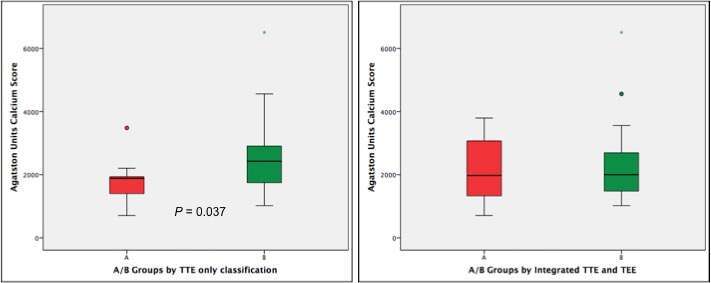
Comparison of Aortic Stenosis Binary Grouping Correlation With Agatston CT Score by Different Echo Modalities

Background: Aortic stenosis (AS) classification depends on left-ventricular ejection-fraction (LVEF <≥50%), aortic valve area (AVA<≥1cm2), mean pressure gradient (MG<≥40mmHg), peak velocity<≥400 cm/sec, and stroke-volume index (SVI<≥35ml/m2). Aortic Valve Calcification Agatston CT score (AVC) correlates with AS severity by trans-thoracic echo (TTE). We explored AVC correlation with dichotomous AS grouping by TTE in awake patients (TTE1), sedated patients (TTE2), TEE-only and Integrated TTE1+TEE data.
Methods: 37 TAVI candidates underwent TTE followed by concomitant TTE and TEE under sedation, and coronary CT. Patients were 81.1(77.3-84.6) years old, had LVEF 60% (49-65). 18(48.6%) were women. Based on recommended conservative vs invasive treatment implication (A/B respectively), AS types were clustered separately by each modality (TTE, TEE, and Integrated TTE-TEE) into two operative groups: Group-A (Moderate AS and Normal-Flow Low-Gradient), and Group-B (High-Gradient, Low-EF Low-Flow Low-Gradient, and Paradoxical Low-Flow Low-Gradient). AVC-score diagnostic accuracy in discriminating AS A/B Groups for each echo method was determined by ROC analysis.
Results: AVC-score distribution values for the two AS A/B Groups by awake TTE (TTE1) only and AVC-score re-distribution by Integrated TTE1+TEE is plotted in attached Figure. Only classification by TTE in awake state held discriminative accuracy in A/B grouping, with area under the curve (AUC) of 0.736 (95%CI 0.57-0.9, p=0.2), and optimal threshold value of 1946 AU having 77% sensitivity and 74% specificity. ROC analysis for TTE under sedation had an AUC of 0.592 (95%CI 0.4-0.78, p=0.35), for TEE an AUC of 0.62 (95%CI 0.37-0.87, p=0.4) and for Integrated TTE1+TEE an AUC of 0.52 (95%CI 0.31-0.74, p=0.8).
Conclusions: Our pioneer study demonstrates that aortic valve calcification correlates well with different AS types dichotomized by operative implication through conventional TTE study in awake state. We did not find such correlation for similar TEE classification, whether in isolation or in conjunction with the TTE study.

Powered by Eventact EMS